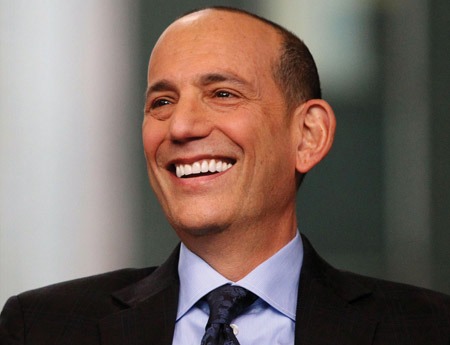Don Garber

When Don Garber was a kid, growing up in Bayside, Queens, the schoolyard was everything. He’d come home from school, make himself a sandwich and head on over to hang out and play. Everybody was Italian, Irish or African-American—“I was the sole Jewish kid in my group of friends,” he says. Not that it mattered; it was all about the asphalt or the field, the competition and camaraderie, and figuring out how to score and win even when you were down. “The schoolyard teaches you you’d better have your feet on the ground, and you’re only as good as you are as a friend—and how good you play,” he says.
Today, Garber is commissioner of Major League Soccer, and the engineer of one of the most remarkable runs in the annals of televised sports. In his 15-year reign atop the operation, MLS has grown from 10 teams to 23 and seen the expansion of more than a dozen soccer-specific stadiums in North America. Last year, on the eve of the World Cup, the league that once had to pay for TV coverage, infomercial style, signed a landmark set of eight-year TV and media rights deals with ESPN, Fox Sports and Univision Deportes. The agreements will reportedly bring the MLS $90 million a year, a fivefold leap from previous levels. That news signaled the fact that MLS is now an integral part of the wave machine that has turned the United States into a far more soccer-loving nation than even boosters had predicted.
The momentum is the fruit of a risky initiative Garber championed in 2002, six years after the league began. He convinced MLS owners to sink hundreds of millions of dollars into the creation of Soccer United Marketing (SUM). The outfit has since grown into one of the world’s leading soccer companies, a warehouse of commercial rights properties that includes the U.S. Soccer Federation and the Mexican Soccer Federation. In short, MLS has climbed from what once felt like the minor-league stepbrother of the world’s great game to a place where expansion fees have risen to $100 million (15 times what they were in 2005), and where franchises have taken root in top markets throughout the United States.
Beyond being a dramatic feat of marketing, promotion and management, it is also, in a sense, the culmination story for a quintessential middle-class Queens kid who learned that the rules of the game don’t change much, regardless of the neighborhood you’re operating in. “Whatever I wasn’t smart enough to do, I knew I could do by outworking the next guy,” says Garber.
That work ethic came early, from a mom who worked as a nursery school teacher and an accountant dad. After graduating from the State University of New York at Oneonta, Garber went into public relations, and, while working for Burson-Marsteller, began a journey towards the sports business through working on the company’s M&M Mars account, which was among the sponsors for the 1984 Olympic Games. The company also had NFL interests, but it was Garber who found himself moving over and into business development for NFL Properties, an arm of the league that was at the start of the commercialization of sports movement.
“We were young, we thought we were inventing sports marketing and we did a lot of fun things,” recalls Rick Dudley, the CEO of Octagon. “Don came in and he was incredibly eager to dive in. And he was great in front of a room. You could send him to any company and he’d do a great job of representing the NFL. And when you challenged him he didn’t get flustered; he was truly cool under pressure.”
That theory would be tested in 1991 when the company had to pick one of two sales executives to run the sales group—and it wasn’t Garber. It was, he recalls, the first real back-against-the-wall-challenge moment of his career.
The smarter way to stay on top of broadcasting and cable industry. Sign up below
“I thought I had done a great job, I loved the league, and I didn’t think I’d be fi red,” he says. “And I said, ‘Give me a week; I think there’s a lot of stuff that’s missing at NFL Properties. Let me put together a plan.’ I spent the next week working and the plan led to the creation of the NFL Experience,” which became the league’s first foray into big, sponsor-worthy, fan-friendly events, quickly leading to much more ambitious leveraging of the Super Bowl, and giving Garber a new job and a spot on the radar of NFL commissioner Paul Tagliabue. The commissioner asked Garber to head up the league’s international business, which, at the time, seemed a daunting challenge. But Garber took it, since it suited his big thinking and tenacious nature. While putting in changes that would boost the office’s profits by 400%, he also began to observe the shifting demographics in the United States and the world, especially in terms of young sports fans. The prescient perspective would serve him well when New England Patriots owner Robert Kraft—who also owns the New England Revolution—sought Garber out for a new challenge: becoming commissioner of then-struggling Major League Soccer.
With SUM’s creation, the owners ’ continued and necessary belief in Garber’s vision and his ability to repurpose old NFL successes through the country’s evolving sports fan culture , MLS has become an international winner . Recalling his belief when he took over, Garber says, “The Hispanic population was growing, and I saw that demographics would reflect a country that in my view would likely support soccer more than it had.”
“Don understands the importance of not just the product on the field but the fan experience, the media strategy,” says Brian Bedol, CEO of Bedrocket Media Ventures and founder of Classic Sports Network who consulted with Garber at MLS.
While these are go-go times for the sport, the past year has offered a lot of perspective for Garber. After a bout with cancer last year, he is recovered and is doing well, enjoying life with his wife Betsy and children Maddie and David. MLS continues to grow and the goal is to be among the elite world leagues by 2022. Just as it was on the playground growing up, no one should bet against Garber hitting that target. “I’ve always been a really determined guy that wanted to prove myself,” he says.
Rob has written for Broadcasting+Cable since 2006, starting with his work on the magazine’s award-winning 75th-anniversary issue. He was born a few blocks away from Yankee Stadium … so of course he’s published three books on NASCAR, most notably, Full Throttle: The Life and Fast Times of NASCAR Legend Curtis Turner. He’s currently the special projects editor at TV Guide Magazine. His writing has appeared in The Washington Post and his origami art has been in The Wall Street Journal. He lives with his family in New Jersey and is writing a novel about the Wild West.

